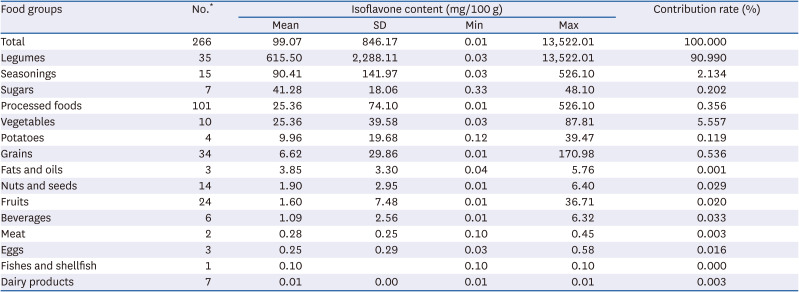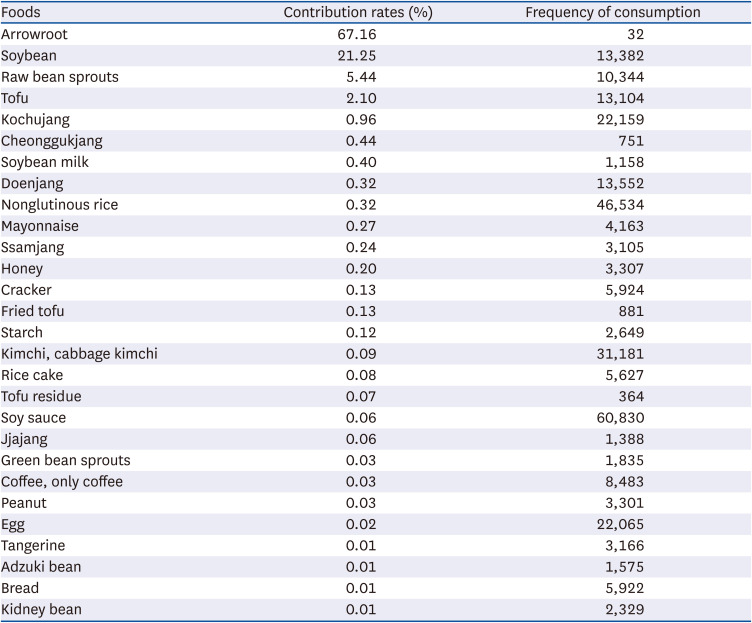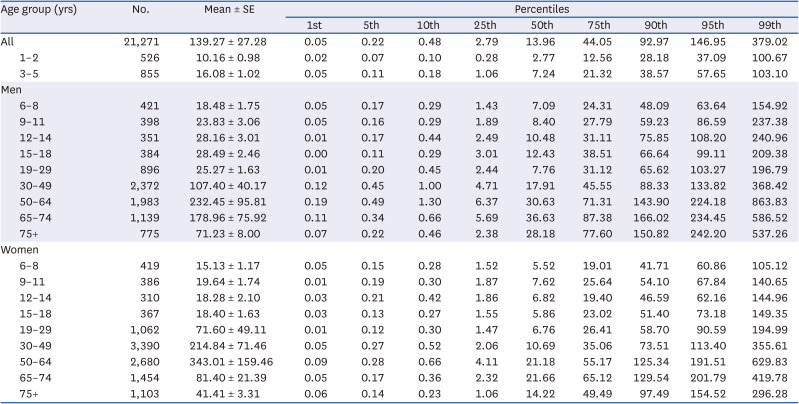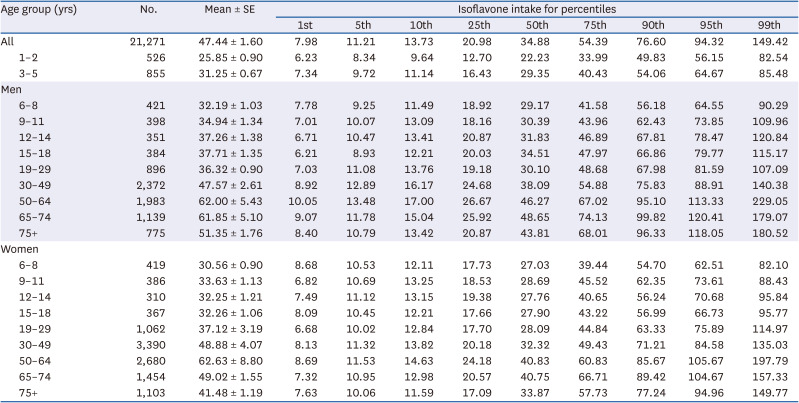1. Kumar S, Pandey AK. Chemistry and biological activities of flavonoids: an overview. Sci World J. 2013; 2013:162750.
2. Kim Y, Keogh JB, Clifton PM. Polyphenols and glycemic control. Nutrients. 2016; 8:17.
3. Manach C, Scalbert A, Morand C, Rémésy C, Jiménez L. Polyphenols: food sources and bioavailability. Am J Clin Nutr. 2004; 79:727–747. PMID:
15113710.
4. Kim HS, Kang BK, Seo JH, Kim HT, Ha TJ, Oh JH, Shin SO, Baek IY. Effect of different planting times on the quantitative variation of total seed isoflavone content and composition in Korean soybean cultivars (Glycine max (L.) Merr.). J Crop Sci Biotechnol. 2021; 24:179–190.
5. Morgan HE, Dillaway D, Edwards TM. Estrogenicity of soybeans (Glycine max) varies by plant organ and developmental stage. Endocr Disruptors (Austin). 2014; 2:e28490.
6. Kurzer MS, Xu X. Dietary phytoestrogens. Annu Rev Nutr. 1997; 17:353–381. PMID:
9240932.
7. Bustamante-Rangel M, Delgado-Zamarreño MM, Pérez-Martín L, Rodríguez-Gonzalo E, Domínguez-Álvarez J. Analysis of Isoflavones in Foods. Compr Rev Food Sci Food Saf. 2018; 17:391–411. PMID:
33350079.
8. Křížová L, Dadáková K, Kašparovská J, Kašparovský T. Isoflavones. Molecules. 2019; 24:1076.
9. Setchell KD, Brown NM, Zimmer-Nechemias L, Brashear WT, Wolfe BE, Kirschner AS, Heubi JE. Evidence for lack of absorption of soy isoflavone glycosides in humans, supporting the crucial role of intestinal metabolism for bioavailability. Am J Clin Nutr. 2002; 76:447–453. PMID:
12145021.
10. Yuan JP, Wang JH, Liu X. Metabolism of dietary soy isoflavones to equol by human intestinal microflora--implications for health. Mol Nutr Food Res. 2007; 51:765–781. PMID:
17579894.
11. Rafii F, Davis C, Park M, Heinze TM, Beger RD. Variations in metabolism of the soy isoflavonoid daidzein by human intestinal microfloras from different individuals. Arch Microbiol. 2003; 180:11–16. PMID:
12783157.
12. Tang J, Wan Y, Zhao M, Zhong H, Zheng JS, Feng F. Legume and soy intake and risk of type 2 diabetes: a systematic review and meta-analysis of prospective cohort studies. Am J Clin Nutr. 2020; 111:677–688. PMID:
31915830.
13. Ruscica M, Pavanello C, Gandini S, Gomaraschi M, Vitali C, Macchi C, Morlotti B, Aiello G, Bosisio R, Calabresi L, et al. Effect of soy on metabolic syndrome and cardiovascular risk factors: a randomized controlled trial. Eur J Nutr. 2018; 57:499–511. PMID:
27757595.
14. Tokede OA, Onabanjo TA, Yansane A, Gaziano JM, Djoussé L. Soya products and serum lipids: a meta-analysis of randomised controlled trials. Br J Nutr. 2015; 114:831–843. PMID:
26268987.
15. Kokubo Y, Iso H, Ishihara J, Okada K, Inoue M, Tsugane S. JPHC Study Group. Association of dietary intake of soy, beans, and isoflavones with risk of cerebral and myocardial infarctions in Japanese populations: the Japan Public Health Center-based (JPHC) study cohort I. Circulation. 2007; 116:2553–2562. PMID:
18025534.
16. Sansai K, Na Takuathung M, Khatsri R, Teekachunhatean S, Hanprasertpong N, Koonrungsesomboon N. Effects of isoflavone interventions on bone mineral density in postmenopausal women: a systematic review and meta-analysis of randomized controlled trials. Osteoporos Int. 2020; 31:1853–1864. PMID:
32524173.
17. Lambert MN, Hu LM, Jeppesen PB. A systematic review and meta-analysis of the effects of isoflavone formulations against estrogen-deficient bone resorption in peri- and postmenopausal women. Am J Clin Nutr. 2017; 106:801–811. PMID:
28768649.
18. Nakamoto M, Otsuka R, Nishita Y, Tange C, Tomida M, Kato Y, Imai T, Sakai T, Ando F, Shimokata H. Soy food and isoflavone intake reduces the risk of cognitive impairment in elderly Japanese women. Eur J Clin Nutr. 2018; 72:1458–1462. PMID:
29348624.
19. Lin HC, Peng CH, Huang CN, Chiou JY. Soy-based foods are negatively associated with cognitive decline in Taiwan’s elderly. J Nutr Sci Vitaminol (Tokyo). 2018; 64:335–339. PMID:
30381623.
20. Tse G, Eslick GD. Soy and isoflavone consumption and risk of gastrointestinal cancer: a systematic review and meta-analysis. Eur J Nutr. 2016; 55:63–73. PMID:
25547973.
21. Jiang R, Botma A, Rudolph A, Hüsing A, Chang-Claude J. Phyto-oestrogens and colorectal cancer risk: a systematic review and dose-response meta-analysis of observational studies. Br J Nutr. 2016; 116:2115–2128. PMID:
28091359.
22. Applegate CC, Rowles JL 3rd, Ranard KM, Jeon S, Erdman JW. Soy consumption and the risk of prostate cancer: an updated systematic review and meta-analysis. Nutrients. 2018; 10:40.
23. Nagata C, Mizoue T, Tanaka K, Tsuji I, Tamakoshi A, Matsuo K, Wakai K, Inoue M, Tsugane S, Sasazuki S, et al. Soy intake and breast cancer risk: an evaluation based on a systematic review of epidemiologic evidence among the Japanese population. Jpn J Clin Oncol. 2014; 44:282–295. PMID:
24453272.
24. Qiu S, Jiang C. Soy and isoflavones consumption and breast cancer survival and recurrence: a systematic review and meta-analysis. Eur J Nutr. 2019; 58:3079–3090. PMID:
30382332.
25. Franco OH, Chowdhury R, Troup J, Voortman T, Kunutsor S, Kavousi M, Oliver-Williams C, Muka T. Use of plant-based therapies and menopausal symptoms: a systematic review and meta-analysis. JAMA. 2016; 315:2554–2563. PMID:
27327802.
26. Li N, Wu X, Zhuang W, Xia L, Chen Y, Zhao R, Yi M, Wan Q, Du L, Zhou Y. Soy and isoflavone consumption and multiple health outcomes: umbrella review of systematic reviews and meta-analyses of observational studies and randomized trials in humans. Mol Nutr Food Res. 2020; 64:e1900751. PMID:
31584249.
27. Cederroth CR, Zimmermann C, Nef S. Soy, phytoestrogens and their impact on reproductive health. Mol Cell Endocrinol. 2012; 355:192–200. PMID:
22210487.
28. Bennetau-Pelissero C. Risks and benefits of phytoestrogens: where are we now? Curr Opin Clin Nutr Metab Care. 2016; 19:477–483. PMID:
27749767.
29. Adgent MA, Daniels JL, Edwards LJ, Siega-Riz AM, Rogan WJ. Early-life soy exposure and gender-role play behavior in children. Environ Health Perspect. 2011; 119:1811–1816. PMID:
21813368.
30. Kim J, Kim S, Huh K, Kim Y, Joung H, Park M. High serum isoflavone concentrations are associated with the risk of precocious puberty in Korean girls. Clin Endocrinol (Oxf). 2011; 75:831–835. PMID:
21623856.
31. Domínguez-López I, Yago-Aragón M, Salas-Huetos A, Tresserra-Rimbau A, Hurtado-Barroso S. Effects of dietary phytoestrogens on hormones throughout a human lifespan: a review. Nutrients. 2020; 12:2456.
32. Messina M, Nagata C, Wu AH. Estimated Asian adult soy protein and isoflavone intakes. Nutr Cancer. 2006; 55:1–12. PMID:
16965235.
33. Wakai K, Egami I, Kato K, Kawamura T, Tamakoshi A, Lin Y, Nakayama T, Wada M, Ohno Y. Dietary intake and sources of isoflavones among Japanese. Nutr Cancer. 1999; 33:139–145. PMID:
10368808.
34. Chan SG, Ho SC, Kreiger N, Darlington G, So KF, Chong PY. Dietary sources and determinants of soy isoflavone intake among midlife Chinese women in Hong Kong. J Nutr. 2007; 137:2451–2455. PMID:
17951484.
35. Kim K, Vance TM, Chun OK. Estimated intake and major food sources of flavonoids among US adults: changes between 1999-2002 and 2007-2010 in NHANES. Eur J Nutr. 2016; 55:833–843. PMID:
26026481.
36. Chun OK, Chung SJ, Song WO. Urinary isoflavones and their metabolites validate the dietary isoflavone intakes in US adults. J Am Diet Assoc. 2009; 109:245–254. PMID:
19167951.
37. Mulligan AA, Welch AA, McTaggart AA, Bhaniani A, Bingham SA. Intakes and sources of soya foods and isoflavones in a UK population cohort study (EPIC-Norfolk). Eur J Clin Nutr. 2007; 61:248–254. PMID:
16943849.
38. Mulligan AA, Kuhnle GG, Lentjes MA, van Scheltinga V, Powell NA, McTaggart A, Bhaniani A, Khaw KT. Intakes and sources of isoflavones, lignans, enterolignans, coumestrol and soya-containing foods in the Norfolk arm of the European Prospective Investigation into Cancer and Nutrition (EPIC-Norfolk), from 7 d food diaries, using a newly updated database. Public Health Nutr. 2013; 16:1454–1462. PMID:
22939391.
39. van Erp-Baart MA, Brants HA, Kiely M, Mulligan A, Turrini A, Sermoneta C, Kilkkinen A, Valsta LM. Isoflavone intake in four different European countries: the VENUS approach. Br J Nutr. 2003; 89(Suppl 1):S25–S30. PMID:
12725653.
40. Murphy KJ, Walker KM, Dyer KA, Bryan J. Estimation of daily intake of flavonoids and major food sources in middle-aged Australian men and women. Nutr Res. 2019; 61:64–81. PMID:
30683440.
41. Zamora-Ros R, Andres-Lacueva C, Lamuela-Raventós RM, Berenguer T, Jakszyn P, Barricarte A, Ardanaz E, Amiano P, Dorronsoro M, Larrañaga N, et al. Estimation of dietary sources and flavonoid intake in a Spanish adult population (EPIC-Spain). J Am Diet Assoc. 2010; 110:390–398. PMID:
20184989.
42. Kim J, Kwon C. Estimated dietary isoflavone intake of Korean population based on national nutrition survey. Nutr Res. 2001; 21:947–953. PMID:
11446978.
43. Lee MJ, Kim MJ, Min SH, Yoon S. A study on the attitude of soy food and estimated dietary isoflavone intake among Korean adolescents. Korean J Community Nutr. 2004; 9:606–614.
44. Lee SK, Lee MJ, Yoon S, Kwon DJ. Estimated isoflavone intake from soy products in Korean middle-aged women. J Korean Soc Food Sci Nutr. 2000; 29:948–956.
45. Lee MJ, Kim JH. Estimated dietary isoflavone intake among Korean adults. Nutr Res Pract. 2007; 1:206–211. PMID:
20368940.
46. Kweon S, Kim Y, Jang MJ, Kim Y, Kim K, Choi S, Chun C, Khang YH, Oh K. Data resource profile: the Korea National Health and Nutrition Examination Survey (KNHANES). Int J Epidemiol. 2014; 43:69–77. PMID:
24585853.
47. Korea Centers for Disease Control and Prevention. Findings from Korea National Health and Nutrition Examination Survey [Internet]. Cheongju: Korea Centers for Disease Control and Prevention;2018. cited 2021 June 12. Available from:
https://knhanes.kdca.go.kr/knhanes/sub01/sub01_05.do#s5_02.
49. Park M. Preparation of Korean isoflavone database and evaluation of isoflavone intake among Korean adolescents [master’s thesis]. Seoul: Seoul National University;2005.
50. Bhagwat S, Haytowitz DB, Holden JM. USDA Database for the Isoflavone Content of Selected Foods, Release 2.0. Washington, D.C.: U.S. Department of Agriculture, Agricultural Research Service, Nutrient Data Laboratory;2008.
51. Zamora-Ros R, Knaze V, Luján-Barroso L, Kuhnle GG, Mulligan AA, Touillaud M, Slimani N, Romieu I, Powell N, Tumino R, et al. Dietary intakes and food sources of phytoestrogens in the European Prospective Investigation into Cancer and Nutrition (EPIC) 24-hour dietary recall cohort. Eur J Clin Nutr. 2012; 66:932–941. PMID:
22510793.
52. Bai W, Wang C, Ren C. Intakes of total and individual flavonoids by US adults. Int J Food Sci Nutr. 2014; 65:9–20. PMID:
24020353.
53. Bosetti C, Rossi M, McLaughlin JK, Negri E, Talamini R, Lagiou P, Montella M, Ramazzotti V, Franceschi S, LaVecchia C. Flavonoids and the risk of renal cell carcinoma. Cancer Epidemiol Biomarkers Prev. 2007; 16:98–101. PMID:
17220336.
54. Ovaskainen ML, Törrönen R, Koponen JM, Sinkko H, Hellström J, Reinivuo H, Mattila P. Dietary intake and major food sources of polyphenols in Finnish adults. J Nutr. 2008; 138:562–566. PMID:
18287367.
55. Peterson J, Lagiou P, Samoli E, Lagiou A, Katsouyanni K, La Vecchia C, Dwyer J, Trichopoulos D. Flavonoid intake and breast cancer risk: a case--control study in Greece. Br J Cancer. 2003; 89:1255–1259. PMID:
14520456.
56. Kim J, Kim HJ, Joung H, Park MK, Li S, Song Y, Franke AA, Paik HY. Overnight urinary excretion of isoflavones as an indicator for dietary isoflavone intake in Korean girls of pubertal age. Br J Nutr. 2010; 104:709–715. PMID:
20385037.
57. Park MK, Song Y, Joung H, Li SJ, Paik HY. Establishment of an isoflavone database for usual Korean foods and evaluation of isoflavone intake among Korean children. Asia Pac J Clin Nutr. 2007; 16:129–139. PMID:
17215190.
58. Lee HS, Cho YH, Park J, Shin HR, Sung MK. Dietary intake of phytonutrients in relation to fruit and vegetable consumption in Korea. J Acad Nutr Diet. 2013; 113:1194–1199. PMID:
23830325.
59. Wada K, Nakamura K, Masue T, Sahashi Y, Ando K, Nagata C. Soy intake and urinary sex hormone levels in preschool Japanese children. Am J Epidemiol. 2011; 173:998–1003. PMID:
21427172.
60. Hu XJ, Song WR, Gao LY, Nie SP, Eisenbrand G, Xie MY. Assessment of dietary phytoestrogen intake via plant-derived foods in China. Food Addit Contam Part A Chem Anal Control Expo Risk Assess. 2014; 31:1325–1335. PMID:
24950423.
61. Hsiao AKF, Lyons-Wall PM. Soy consumption in Taiwanese children in Taipei. J Nutr. 2000; 130:705S.










 PDF
PDF Citation
Citation Print
Print



 XML Download
XML Download